The automotive industry continues to face problems. Just when there were signs of relief along supply chains, the Ukraine war and an Omicron surge in China added new uncertainties. Continuously rising gasoline prices are also increasing the pressure to switch drive systems. However, EVs are even more digital by design – and Germany continues to be short of skilled software developers.
Although the Chinese automotive industry is already very strong in the fields of electromobility and digitalization, it is now increasing its lead even further. Geely, the owner of Volvo, has bundled its technology activities in the subsidiary EcarX, which we are presenting in today’s issue. EcarX develops software and manages the manufacturing of corresponding chips. With this strategy, Geely is reinforcing its position as a pioneer of smart driving, analyzes Frank Sieren.
The weather forecast predicts a drop in temperatures in Germany this weekend, and next week, rain is finally expected. In general, however, this year has once again already started with too little precipitation. The effect of climate change on forests, therefore, remains a pressing issue. After the clearcutting of the past few years, reforestation is now on the agenda. Learning from China, which has a lot of experience in this area, would seem like an obvious step. But tree planting has long since become a mere quota that needs to be met, analyzes Ning Wang. Saplings often grow poorly, and artificial forests are neither as robust nor as climate-effective as the real thing.

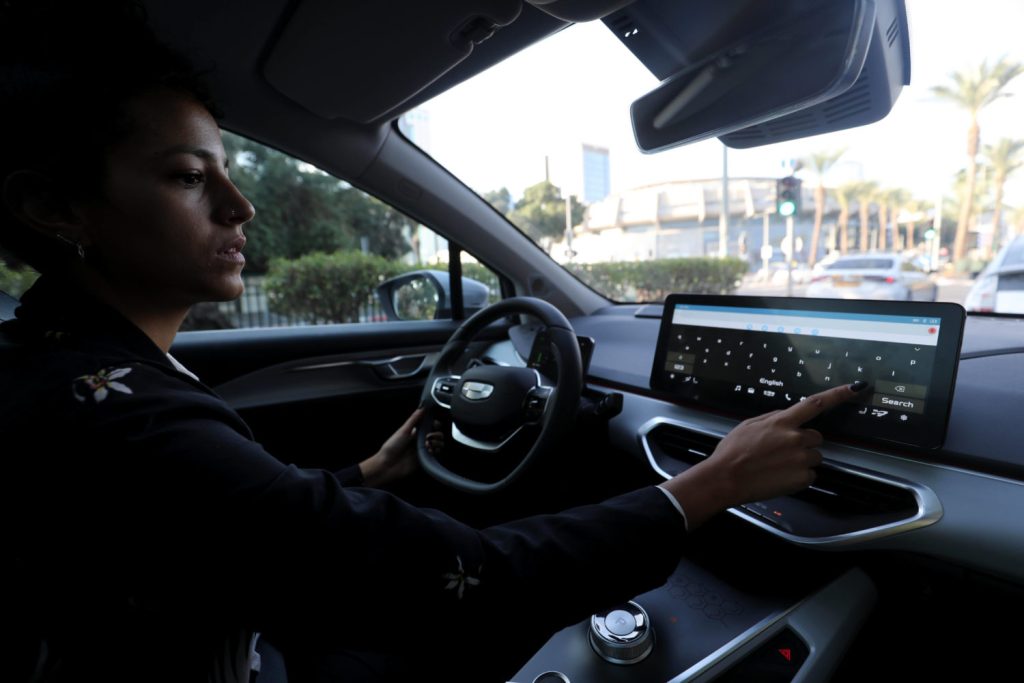
The three major challenges the German automotive industry has faced recently have been chip shortages, the rapid transition to new drive systems, and rapid digitization, which still lacks software developers. These three issues overlap and amplify each other: The car of the future includes a particularly large number of computer functions and needs not just a large number of semiconductors, it also needs particularly advanced ones.
To this end, Hangzhou-based carmaker Geely now takes software development and chip design into its own hands – and even handles the production. Particularly remarkable here are Geely’s plans for the group company EcarX. It was founded in 2016 by Geely owner Li Shufu and CEO Shen Ziyu. Now it is the platform on which the group plans to offer a variety of connected digital services for cars. EcarX’s software, for example, is expected to one day take control in autonomous driving. It is also intended to widely replace third-party programs from Google.
The development of such services costs a lot of money. That is why EcarX plans to go public in the United States. To do so, it is using the somewhat dubious structure of a listed shell company, with which EcarX will merge to become tradable without a formal initial listing. The transaction would be valued at about $4 billion, Bloomberg reports. But the company still has to convince regulators on both sides of the Pacific that everything is above board.
An important part of EcarX’s systems is developed at a hidden champion in the Bavarian town of Landshut: HiveMQ, a startup founded there in 2012, offers programs that ensure that various computers and systems within cars communicate with each other quickly and without errors. Specifically, HiveMQ is a company that specializes in the MQTT communication protocol. It is used to connect the devices in our increasingly networked world. In other words, it enables the “Internet of Things”. MQTT stands for Message Queuing Telemetry Transport.
At EcarX, HiveMQ is, for example, used to handle data traffic between the car and the cloud. The startup’s technology can be used to send commands to a car remotely – for example, to send a digital key for car sharing, adjust the air conditioning before starting the engine, or unlock the car. But this also includes data about its surroundings, from other cars or the city’s traffic computers for autonomous driving.
According to the Landshut-based company, more than 130 companies worldwide already use their technology, including BMW and Audi. With its 19 employees, the company now has an annual revenue of €2 million.
The major client EcarX operates branches and development hubs in the cities of Hangzhou, Beijing, Shanghai, Wuhan, Dalian – and since 2020 also in Gothenburg, Sweden, i.e. at the Group’s sister company Volvo. In March 2021, Volvo and EcarX had agreed to jointly develop an infotainment platform. EcarX in turn has a 15 percent stake in Zenseact, a Volvo subsidiary that specializes in autonomous driving software.
Volvo had been acquired by Geely in 2010. Geely founder Li Shufu wants to dominate the EV market with several brands. And EcarX is part of this vision. The system already networks two million cars in the Geely brand family. Li is also the largest single shareholder in Daimler.
Built on Zenseact’s global software platform, the companies now plan to work together on autonomous driving in China. In the next step, the upcoming models from Polestar and Volvo in particular will be fitted with the technology for autonomous driving on highways. “Zenseact is a pioneer in self-driving technology, and this strategic investment from ECARX enables us to scale up quicker in China,” said Håkan Samuelsson, CEO of Volvo and chairman of the board of Zenseact.
Demand for autonomous driving technology continues to rise in China. Geely has also embarked on perhaps the most important milestone in this regard with EcarX: The development of its own high-quality 7-nanometer chipsets. This is China’s first 7-nanometer chip for in-car use. This is no small feat. The American semiconductor manufacturer Intel had long failed to get the production of chips with such a small structure width up and running.
The Geely chip, called SE1000, is expected to go into mass production as early as the third quarter of this year, or early 2023 at the latest. It was developed by Siengine, a joint venture between EcarX and Hubei province-based chipmaker Arm China. The chip uses advanced architecture to improve performance for artificial intelligence. It supports “various AI calculations and provides improved security,” the company explains. Three main product lines will be developed, including chips for autonomous driving and chips for centralized in-car data processing. By 2025, Geely aims to put cars on the road at Level 5, the highest level of autonomous driving. The in-house chips will then be available with high processing power, the company explains.
The chip shortage and US sanctions have led many carmakers to rely on their own capacities in order to shorten the development time and tailor the chips to their own needs. But Apple and Huawei’s Chinese subsidiary Hisilicon also report that their development efforts are already well advanced. Geely is also working closely with Apple supplier Foxconn in this area. Their joint venture Shandong Fujikang Intelligent Manufacturing works on intelligent control systems, among other things.
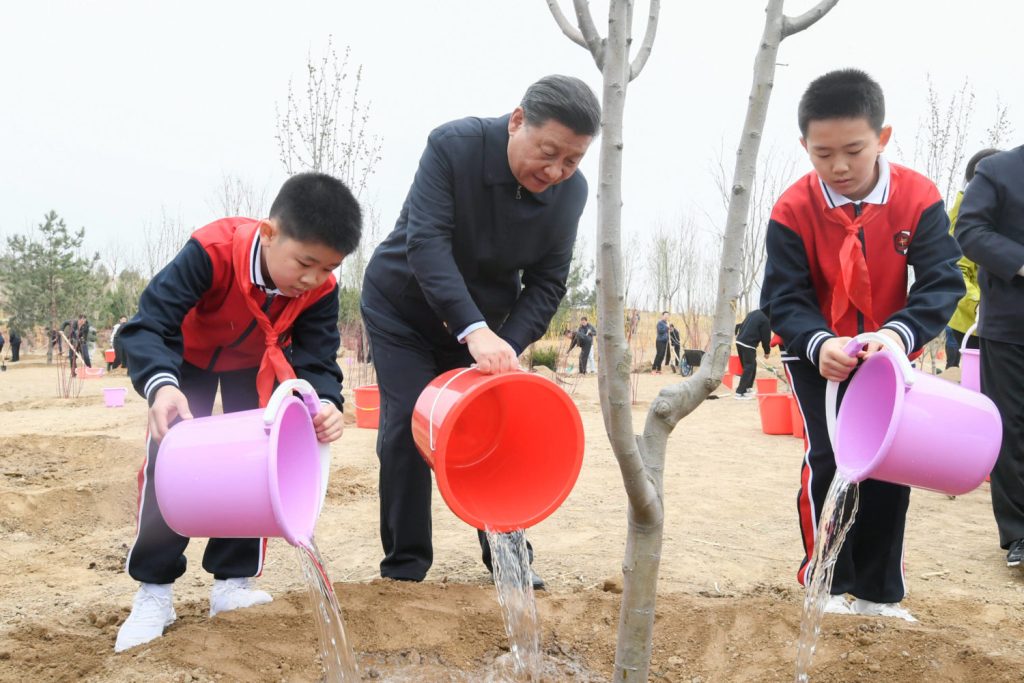
In Ritan Park in central Beijing, some trees bear special signs such as “Nine Dragon Cypress”. Some of the park’s 44 ancient specimens are fenced off, their hanging branches supported by wooden poles. The trees are several hundred years old and thus sacred, so to speak. Such old trees are rather special. They have become rare in the metropolises of the People’s Republic. For decades, urban planning had left little room for recreational parks. For many years, storms from the west swept fine grains of sand from the Gobi Desert across the city in the spring.
To get this problem under control, Beijing has launched several reforestation programs since 1978. To date, these are the most extensive projects of their kind anywhere in the world. They bear beautiful names such as “Great Green Wall,” “Three North Shelterbelt” or “Grain for Green”. To ward off dust storms from the Gobi Desert alone, a sum of ¥60 million ($7.3 billion) was earmarked for reforestation in the 10th Five-Year Plan (2002-2006).
Dust storms have indeed become rarer in the capital over the years. But are these massive reforestation projects helping to combat climate change? Numerous new studies say no. Newly planted trees cannot capture enough carbon dioxide to counter global warming, given China’s still-growing emissions. Unless emissions themselves are reduced, success will be slim. And so Beijing’s reforestation efforts serve primarily to fulfill quotas – and now, arguably, to propagandize China’s efforts against climate change worldwide. With a share of around 30 percent of global annual emissions, the People’s Republic is the world’s largest emitter of carbon dioxide by absolute numbers (China.Table reported).
Admittedly, the dimensions are impressive. For example, the “Great Green Wall” project has reforested about 330,000 square kilometers – an area almost the size of Germany. On the occasion of the recent International Day of Forests on March 21, state media announced that China had planted 3.6 million hectares of forest last year alone. If the Forestry and Grassland Administration has its way, this will continue until 2025. Accordingly, China wants to cover an additional area of roughly 35,000 km2 with forest every year (China.Table reported). The share of forests of the country’s total area is to increase from currently 23.04 percent to 24.1 percent.
However, not all forests are the same. For example, China is planting a particularly large number of eucalyptus trees. “What we see is that forest area increases quickly at first and then drops again,” says Dr. Susanne Winter, Forest Policy Director at WWF. “Often, as in many other parts of the world, poplars, eucalyptus or acacias are planted because these eucalyptus plantations are highly productive,” Winter explains. “But for biodiversity, required to make a forest more resilient, these monocultures are not suitable.”
Just in mid-March, researchers from seven countries, including China, the United Kingdom and Brazil, analyzed data from 25,950 records across 264 studies in 53 countries. They found that various native trees consistently have a better ecological impact than monoculture tree plantations in roles such as carbon storage, prevention of soil erosion and water supply. A monoculture can only store about twelve tons of carbon per hectare. A biodiverse forest, on the other hand, achieves 32 tons.
China also has a problem with primary forests – forests that humans have not yet damaged through logging or clearing. Global Forest Watch has calculated that China’s primary forest areas decreased by 4.4 percent between 2002 and 2020. This also has implications for species conservation. For example, many plant and animal species exist only in primary forests. “Some fungi, beetles and worms that exist in primary forests are no longer present in young forests because they are adapted to older trees,” says Susanne Winter of the WWF.
China’s forests are still severely affected. Annual timber yields per hectare are only about one-twentieth of Germany’s forests. Thus, the People’s Republic remains heavily dependent on wood imports to meet the demand of its manufacturing industry. “While domestic wood production is stable at 80 million cubic meters per year, demand approached 570 million cubic meters in 2017, equal to about 15 percent of global wood production,” the German Society for International Cooperation (GIZ) reported on a joint project between the German Federal Ministry of Food and Agriculture (BMEL) and the National Forestry and Grassland Administration of China (NFGA). The goal of the project was to shape Chinese forest policy toward more sustainable forest management.
Moreover, China’s imported deforestation is “very, very high,” says Winter of WWF. That means China’s demand is leading to deforestation elsewhere. According to a WWF study, China’s imports of agricultural commodities drive global deforestation more than any other country – even more than the United States and the European Union combined. For example, China is one of the largest contributors to tropical rainforest deforestation in Brazil. Demand for Brazilian soy has nearly tripled since 2010. And yet, as studies have shown, one hectare of tropical forest stores an average of 100 to 200 tons of carbon. China’s soy imports are thus climate-damaging.
Thanks to all the trees, the sky over Beijing has become blue again in the meantime and the air quality has improved. This does not change the fact that the problems have been exported and have actually grown bigger.
On the sidelines of a long-planned Afghanistan conference, China and Russia have reaffirmed their strategic partnership. Russian Foreign Minister Sergey Lavrov traveled to China on Wednesday for the first time since the start of the Ukraine war. He first met his counterpart Wang Yi in Tunxi in the province of Anhui. Lavrov gave assurances that his country wants to “reduce tensions” in the Ukraine war and to continue peace talks with Ukraine, according to the Foreign Ministry in Beijing.
Based on this, China remains committed to the Russian line in the conflict and apparently also trusts Russian assurances. China has so far refused to publicly condemn the Russian invasion. This was also the case on Wednesday: Wang Yi reportedly repeated old familiar Chinese statements during the meeting.
The Ukraine issue was not only the result of a long-lasting security conflict, but also of a Cold War mentality and confrontation. China is supporting Russia and Ukraine to overcome their difficulties in peace talks. In the long run, lessons have to be learned from the crisis, Wang Yi added. The “legitimate security interests of all parties” must be safeguarded and sustainable security architecture in Europe must be created through dialogue and negotiations, the ministry quoted him as saying. Earlier on Tuesday, Wang had called the practice of “choosing sides” and dividing the world undesirable in a video call with EU High Representative for Foreign Affairs Josep Borrell. (China.Table reported)
The fact that China and Russia are now once again showing unity is likely to put a damper on the West’s efforts to persuade China to adopt a more Russia-critical stance just two days before the EU-China summit.
Wang and Lavrov announced in a joint statement the expansion of their “strategic partnership” in a “difficult international situation”. In other words, they are planning for a common future: Both countries want to coordinate more closely on foreign policy and take a common stance on international affairs. “We will move together with you, together with our other like-minded people, towards a multipolar, just, democratic world order,” Wang said, according to the Russian news agency Tass. Lavrov had stressed in an interview before his trip, “It is the best relations we have ever had with China in history.” However, there was no word from the talks about possible Russian requests for Chinese aid.
The meeting is “an opportunity for Lavrov to have bilateral meetings with different parties,” the South China Morning Post quoted Zhao Long of the Shanghai Institute for International Studies as saying. China is hosting a series of meetings in Tunxi, where Taliban Foreign Minister Amir Chan Muttaki and diplomats from the United States are also expected to attend. Among other things, Afghanistan’s neighboring states will discuss possible humanitarian assistance for the crisis-ridden country. Wang Yi visited Kabul only last week and expressed the prospect of economic cooperation (China.Table reported). ck
The lockdown in Shanghai is increasingly affecting the global economy. Volkswagen was forced to scale back production at its joint venture with SAIC Motor on Wednesday due to a shortage of parts. Assembly lines at Tesla were also at a standstill. Thyssenkrupp and Ireland-based auto supplier Aptiv also reported downtimes.
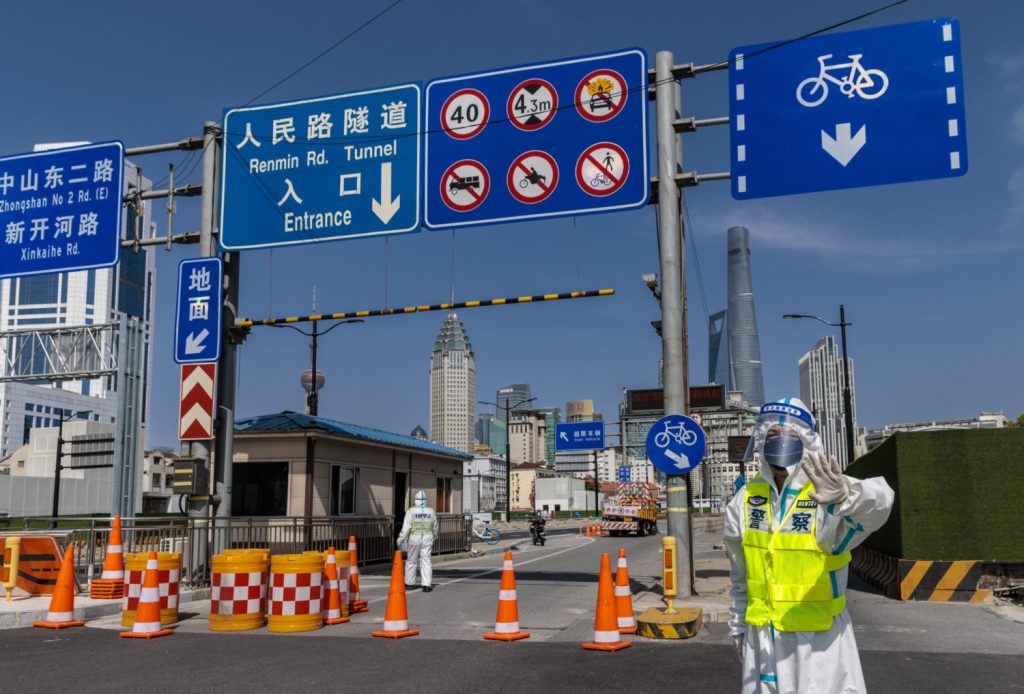
Meanwhile, the lockdown is increasingly affecting the international economy. Volkswagen was forced to scale back production at its joint venture with SAIC Motor on Wednesday due to a shortage of parts. At Tesla , assembly lines were also at a standstill. Thyssenkrupp and the automotive supplier Aptiv from Ireland also reported outages.
At the same time, Chinese companies halted IPOs that were expected to raise more than $9 billion. Meanwhile, the central government acknowledged how dangerous a lockdown in such an important economic center as Shanghai could be for the economy. The State Council announced new measures on CCTV television to shore up the economy. Because Shanghai is an industrial and commercial hub, concerns about global supply chains are also mounting. Danish shipping company Maersk is already warning of rising freight costs.

The strict lockdown is intended to prevent an emerging outbreak of the Omicron variant of Sars-CoV-2. A new high of 5982 new infections had the government on edge. The number sounds manageable, to be sure. But Omicron spreads exponentially even in largely vaccinated populations, as can be observed in Europe and the United States. Among elderly people who have been given the inactivated vaccines commonly used in China – or who have not been vaccinated at all – a high mortality rate would then be expected. The hope now is that the numbers will quickly decline with the lockdown.
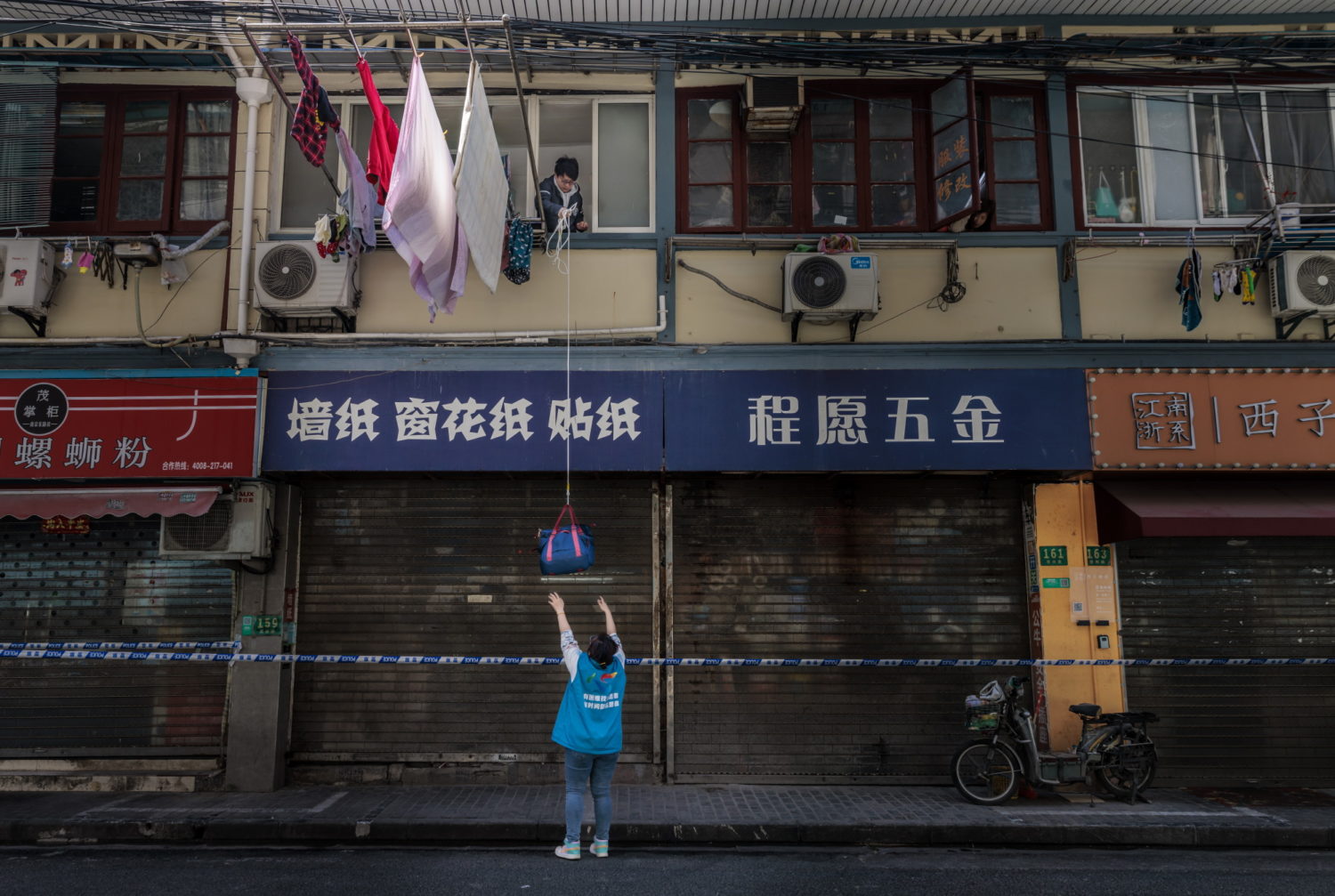
In the meantime, citizens are hoarding supplies because they do not know how long the lockdown will truly last. The government has broken its promises twice within a few days. First, it was said that no lockdown was planned at all. Now came the early extension to further city districts. As a result, residents report great distrust of further announcements by the city government. In supermarkets, fights broke out over remaining groceries. Long queues formed at the last well-supplied stores (here an Aldi).
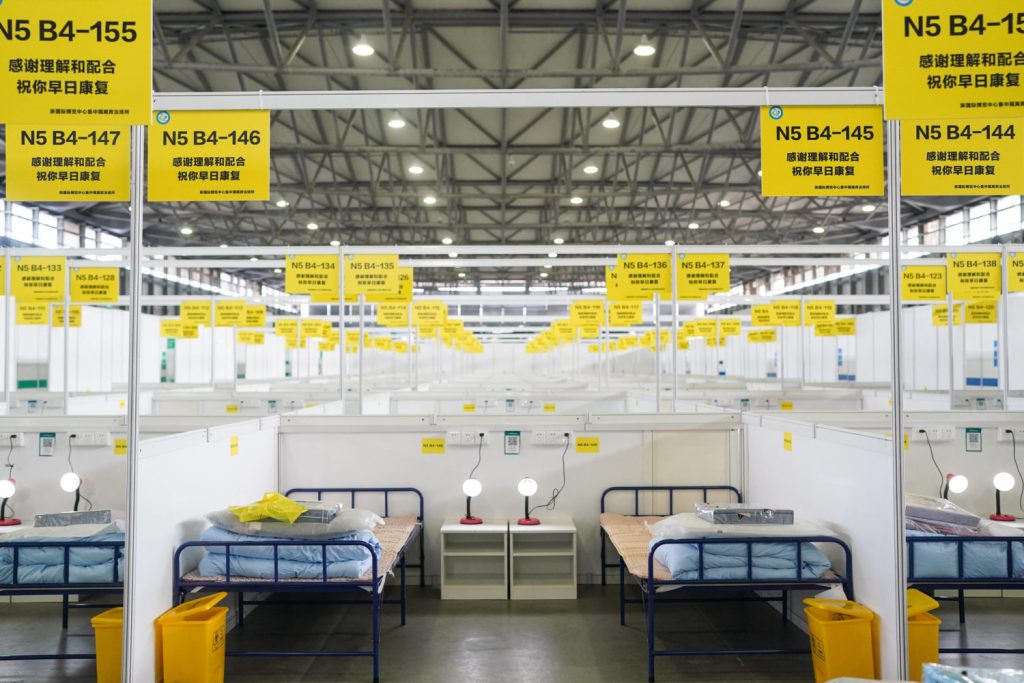
The eerie silence on the street is currently interrupted only by announcements from robotic loudspeakers. Some Shanghainese have moved into their offices. To be able to segregate the citizens identified as positive in the mass testing, the city has constructed large quarantine centers. So far, these are largely empty. But authorities are apparently also preparing for further deteriorating scenarios. fin
In a surprise move, the UK is withdrawing its judges from Hong Kong’s Supreme Court over the National Security Act. “We have seen a systematic erosion of liberty and democracy in Hong Kong,” British Foreign Secretary Liz Truss said in London on Wednesday, explaining the decision. Since the introduction of the Security Act, freedom of expression and freedom of the press have been systematically suppressed. “The situation has reached a tipping point where it is no longer tenable for British judges to sit on Hong Kong’s leading court, and would risk legitimizing oppression,” Truss added.
The Supreme Court, Britain’s highest court, had continuously reviewed the situation in cooperation with the British government before deciding to withdraw the judges, the statement said. British judges have continued to serve in Hong Kong’s judiciary since the territory was returned in 1997. But the Security Act represents a violation of the 1984 Sino-British Joint Declaration, Truss said. The declaration had been the basis for the handover. The National Security Act has been in effect since June 2020. ari
China’s Shenzhen-based EV and battery company BYD has significantly increased revenue in 2021. At its annual press conference on Wednesday, the company announced that revenue increased by 38 percent – from ¥153 billion (€21.6 billion) in 2020 to ¥211 billion (€29.9 billion). BYD’s car revenue increased by 73.3 percent to 740,100 vehicles in the same period.
However, the welcome increase in revenue did not lead to higher profits. On the contrary: BYD had to accept a 28 percent drop in net profit to around ¥3 billion in 2021. Its gross margin was also significantly lower at 11 percent; in 2020, it was still 18 percent. This is largely due to the shortages and increased prices of various raw materials. As a result, BYD had recently increased the sales prices of several car models (China.Table reported). BYD produces both cars with combustion engines and EVs and electric buses. The group now sells the latter worldwide. ck

China’s pledge to stop building new coal-fired power plants abroad, announced during the UN General Assembly in September 2021 – and reiterated during an EU-China dialogue on climate in October 2021 – was met with enthusiasm. Yet, half a year later, little is known about the extent of China’s rollback of its overseas coal projects. Analysis by Just Finance International’s found that Chinese state-owned enterprises (SOEs) seem to have scored over $18 billion (in contracted value) for 67 unidentified overseas coal-fired power projects in 2021 alone. As the EU prepares for high-level climate talks with China, it should request that China discloses its plans for overseas coal projects.
Big promises must be followed by real action if they are to be more than window-dressing. As the largest public financer of overseas coal-fired power plants, China’s promise to end construction has immense potential for reducing global emissions – if the exit is immediate and includes all plants not yet built. Coal power plants, once connected to the grid, will pump out emissions for decades.
If China’s pledge is really aimed at having a positive climate impact, it should make public a transparent account of overseas coal projects, including construction contracts, along with financing, insurance and equipment supply. It should provide information about the status of each project – including which projects have been ceased, which plants are proposed, under negotiation, or under construction, along with the source of project financing.
In May 2021, the International Energy Agency stressed that “no further final investment decisions for new unabated coal plants” could be made if we are to reach net-zero by 2050. Yet NGOs’ analyses from late 2021 show if left undefined, the broad and vague terms of China’s “international coal exit” means that it is potentially implicated in the undertaking of 30-40 GW of active coal projects in Bosnia-Herzegovina, Indonesia, South Africa, and several other countries.
China’s leading lender, the Export-Import Bank of China (China Eximbank), which has financed many of China’s overseas coal projects, recently confirmed that the bank no longer provides loans for overseas coal projects. However, not all financial institutions, such as investors and insurers, have followed suit.
Achieving global climate goals demands the leaders of every country to shoulder responsibility. Climate diplomacy will be on the agenda during the EU-China summit; Germany, as a large and influential EU country, could demonstrate leadership by persuading China, through informal and diplomatic means to clarify its pledge, and to adapt standards aligned with the OECD coal-fired sector understanding from October 2021.
EU enlargement candidate countries in the Western Balkans are home to China’s major overseas coal hotspots. As new Western Balkan coal projects no longer qualify for financing from multilateral development banks or OECD export credit agencies, whose policies prohibit the financing of new coal projects, China is now their only source of financing. In February, an EU delegation visiting Bosnia and Herzegovina reaffirmed the EU’s position that “the construction of a new coal plant in Tuzla is not economically and environmentally sustainable”.
The 2017 loan agreement from China Eximbank for the Tuzla 7 coal-fired power project has caused serious repercussions due to state aid disputes, according to the Energy Community, the EU energy watchdog. Five years later, although construction has not begun, the leading Chinese SOE contractor China Gezhouba Group has not signaled any willingness to leave the project. What appears to be a decision by Chinese banks to no longer provide financing for Bosnia’s newly proposed Ugljevik III coal project may be a sign of China’s regional rethinking of coal. However, its Chinese construction contractor has yet to officially announce an exit.
All Western Balkan countries have committed “to move faster [towards] sustainable and climate-friendly societies in line with the Paris Agreement” and “to accelerate the implementation of the EU Acquis under the Energy Community and Transport Community Treaties” by signing the 2018 Sofia Declaration. Yet failing to end China’s financing and construction of new coal power plants not only stands in stark contrast to this, it is in direct conflict with EU interests.
According to our analysis, Chinese large-scale infrastructure projects, including existing Chinese-built coal power plants, have a history of pollution and legal irregularities. The subversion of, and violation of the rule of law by Chinese investments in the countries of the Western Balkans, as well as the non-compliance with international standards in the implementation of Belt and Road projects, is common practice. Several Chinese coal projects in the Balkans were approved and have qualified for Chinese financing without carrying out legally required environmental impact assessments, often against the backdrop of deceptive feasibility studies. According to a study by the Balkan Investigative Reporting Network, out of 130 such projects, most are “accompanied by allegations of corruption, exploitation and environmental harm”.
What the EU must do: If China’s pledge to stop financing new overseas coal is genuinely aimed at having a positive and critical impact on countering the climate crisis, then Germany and other EU governments, led by Chancellor Olaf Scholz, must initiate the discussion for a definition of the pledge, its effective date and whether its standards meet minimum OECD standards. The upcoming EU-China summit, the EU-China dialogue on climate, the G7 and G20, provide crucial political moments to advance any such debate.
Wawa Wang, Director Just Finance International, has worked as a policy advisor and investigative researcher for international and European NGOs and trade organizations, and has been a trade and foreign policy advisor. She works with civil society actors to improve access to information and decision-making in development finance.
Vanessa Buth, campaigner at Just Finance International, holds a Ph.D. in political science from UEA in the UK. She has worked as a Senior Research Associate on Brexit and in European Commission research projects. She has extensive experience in non-profit environmental and community engagement initiatives.
Raj Subramaniam will become the new CEO of US logistics and courier services provider FedEx on June 1. The 54-year-old was first elected to FedEx’s board in 2020. Subramaniam is a member of the board of directors of the US Chamber of Commerce’s China Center Advisory Board, the US-India Strategic Partnership Forum and the US-China Business Council.
Ganesh Ramani is the new President of Mars Petcare China. Ramani was previously Director of Business in India, where he began working in sales and marketing for the US pet food company eight years ago. Last year, Mars Petcare announced the construction of a new production site near Tianjin. Starting in 2022, the plant will produce 25 tons of pet food annually for the Chinese market.
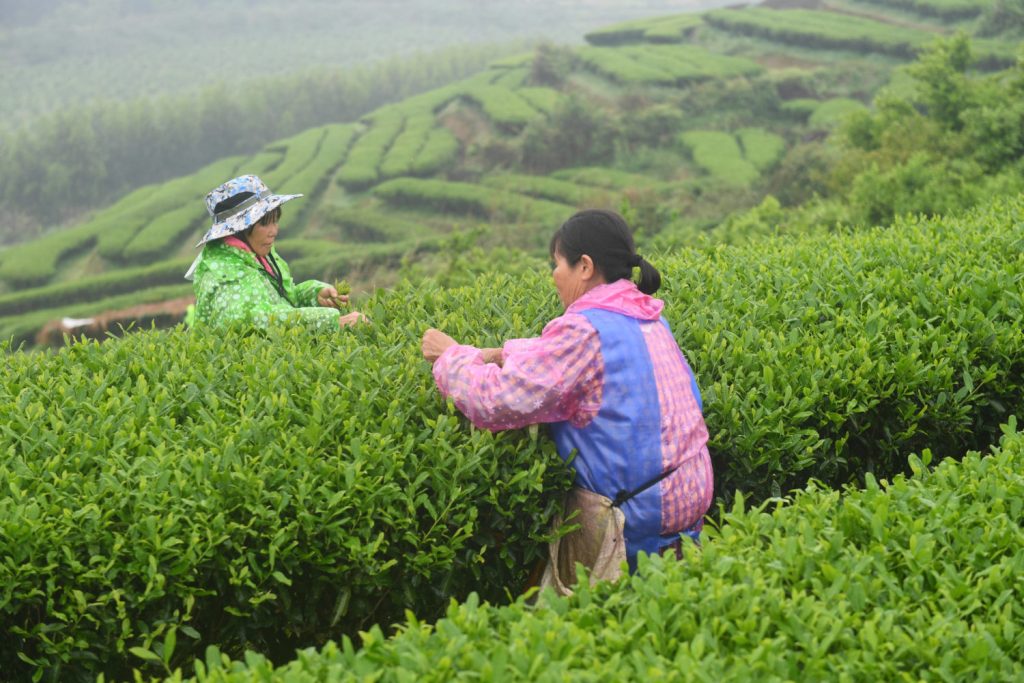
The tea harvest has begun in southern China – even in cold, humid weather. The photo shows two tea farmers in Shanglin in the province of Guangxi. The region belongs to the Huanan (华南) tea region, as do Guangdong, Fujian and Hainan. There, the harvest season always starts first in the country due to the warm, subtropical climate. In general, tea plants can grow in this environment for at least ten months a year.
The automotive industry continues to face problems. Just when there were signs of relief along supply chains, the Ukraine war and an Omicron surge in China added new uncertainties. Continuously rising gasoline prices are also increasing the pressure to switch drive systems. However, EVs are even more digital by design – and Germany continues to be short of skilled software developers.
Although the Chinese automotive industry is already very strong in the fields of electromobility and digitalization, it is now increasing its lead even further. Geely, the owner of Volvo, has bundled its technology activities in the subsidiary EcarX, which we are presenting in today’s issue. EcarX develops software and manages the manufacturing of corresponding chips. With this strategy, Geely is reinforcing its position as a pioneer of smart driving, analyzes Frank Sieren.
The weather forecast predicts a drop in temperatures in Germany this weekend, and next week, rain is finally expected. In general, however, this year has once again already started with too little precipitation. The effect of climate change on forests, therefore, remains a pressing issue. After the clearcutting of the past few years, reforestation is now on the agenda. Learning from China, which has a lot of experience in this area, would seem like an obvious step. But tree planting has long since become a mere quota that needs to be met, analyzes Ning Wang. Saplings often grow poorly, and artificial forests are neither as robust nor as climate-effective as the real thing.


The three major challenges the German automotive industry has faced recently have been chip shortages, the rapid transition to new drive systems, and rapid digitization, which still lacks software developers. These three issues overlap and amplify each other: The car of the future includes a particularly large number of computer functions and needs not just a large number of semiconductors, it also needs particularly advanced ones.
To this end, Hangzhou-based carmaker Geely now takes software development and chip design into its own hands – and even handles the production. Particularly remarkable here are Geely’s plans for the group company EcarX. It was founded in 2016 by Geely owner Li Shufu and CEO Shen Ziyu. Now it is the platform on which the group plans to offer a variety of connected digital services for cars. EcarX’s software, for example, is expected to one day take control in autonomous driving. It is also intended to widely replace third-party programs from Google.
The development of such services costs a lot of money. That is why EcarX plans to go public in the United States. To do so, it is using the somewhat dubious structure of a listed shell company, with which EcarX will merge to become tradable without a formal initial listing. The transaction would be valued at about $4 billion, Bloomberg reports. But the company still has to convince regulators on both sides of the Pacific that everything is above board.
An important part of EcarX’s systems is developed at a hidden champion in the Bavarian town of Landshut: HiveMQ, a startup founded there in 2012, offers programs that ensure that various computers and systems within cars communicate with each other quickly and without errors. Specifically, HiveMQ is a company that specializes in the MQTT communication protocol. It is used to connect the devices in our increasingly networked world. In other words, it enables the “Internet of Things”. MQTT stands for Message Queuing Telemetry Transport.
At EcarX, HiveMQ is, for example, used to handle data traffic between the car and the cloud. The startup’s technology can be used to send commands to a car remotely – for example, to send a digital key for car sharing, adjust the air conditioning before starting the engine, or unlock the car. But this also includes data about its surroundings, from other cars or the city’s traffic computers for autonomous driving.
According to the Landshut-based company, more than 130 companies worldwide already use their technology, including BMW and Audi. With its 19 employees, the company now has an annual revenue of €2 million.
The major client EcarX operates branches and development hubs in the cities of Hangzhou, Beijing, Shanghai, Wuhan, Dalian – and since 2020 also in Gothenburg, Sweden, i.e. at the Group’s sister company Volvo. In March 2021, Volvo and EcarX had agreed to jointly develop an infotainment platform. EcarX in turn has a 15 percent stake in Zenseact, a Volvo subsidiary that specializes in autonomous driving software.
Volvo had been acquired by Geely in 2010. Geely founder Li Shufu wants to dominate the EV market with several brands. And EcarX is part of this vision. The system already networks two million cars in the Geely brand family. Li is also the largest single shareholder in Daimler.
Built on Zenseact’s global software platform, the companies now plan to work together on autonomous driving in China. In the next step, the upcoming models from Polestar and Volvo in particular will be fitted with the technology for autonomous driving on highways. “Zenseact is a pioneer in self-driving technology, and this strategic investment from ECARX enables us to scale up quicker in China,” said Håkan Samuelsson, CEO of Volvo and chairman of the board of Zenseact.
Demand for autonomous driving technology continues to rise in China. Geely has also embarked on perhaps the most important milestone in this regard with EcarX: The development of its own high-quality 7-nanometer chipsets. This is China’s first 7-nanometer chip for in-car use. This is no small feat. The American semiconductor manufacturer Intel had long failed to get the production of chips with such a small structure width up and running.
The Geely chip, called SE1000, is expected to go into mass production as early as the third quarter of this year, or early 2023 at the latest. It was developed by Siengine, a joint venture between EcarX and Hubei province-based chipmaker Arm China. The chip uses advanced architecture to improve performance for artificial intelligence. It supports “various AI calculations and provides improved security,” the company explains. Three main product lines will be developed, including chips for autonomous driving and chips for centralized in-car data processing. By 2025, Geely aims to put cars on the road at Level 5, the highest level of autonomous driving. The in-house chips will then be available with high processing power, the company explains.
The chip shortage and US sanctions have led many carmakers to rely on their own capacities in order to shorten the development time and tailor the chips to their own needs. But Apple and Huawei’s Chinese subsidiary Hisilicon also report that their development efforts are already well advanced. Geely is also working closely with Apple supplier Foxconn in this area. Their joint venture Shandong Fujikang Intelligent Manufacturing works on intelligent control systems, among other things.

In Ritan Park in central Beijing, some trees bear special signs such as “Nine Dragon Cypress”. Some of the park’s 44 ancient specimens are fenced off, their hanging branches supported by wooden poles. The trees are several hundred years old and thus sacred, so to speak. Such old trees are rather special. They have become rare in the metropolises of the People’s Republic. For decades, urban planning had left little room for recreational parks. For many years, storms from the west swept fine grains of sand from the Gobi Desert across the city in the spring.
To get this problem under control, Beijing has launched several reforestation programs since 1978. To date, these are the most extensive projects of their kind anywhere in the world. They bear beautiful names such as “Great Green Wall,” “Three North Shelterbelt” or “Grain for Green”. To ward off dust storms from the Gobi Desert alone, a sum of ¥60 million ($7.3 billion) was earmarked for reforestation in the 10th Five-Year Plan (2002-2006).
Dust storms have indeed become rarer in the capital over the years. But are these massive reforestation projects helping to combat climate change? Numerous new studies say no. Newly planted trees cannot capture enough carbon dioxide to counter global warming, given China’s still-growing emissions. Unless emissions themselves are reduced, success will be slim. And so Beijing’s reforestation efforts serve primarily to fulfill quotas – and now, arguably, to propagandize China’s efforts against climate change worldwide. With a share of around 30 percent of global annual emissions, the People’s Republic is the world’s largest emitter of carbon dioxide by absolute numbers (China.Table reported).
Admittedly, the dimensions are impressive. For example, the “Great Green Wall” project has reforested about 330,000 square kilometers – an area almost the size of Germany. On the occasion of the recent International Day of Forests on March 21, state media announced that China had planted 3.6 million hectares of forest last year alone. If the Forestry and Grassland Administration has its way, this will continue until 2025. Accordingly, China wants to cover an additional area of roughly 35,000 km2 with forest every year (China.Table reported). The share of forests of the country’s total area is to increase from currently 23.04 percent to 24.1 percent.
However, not all forests are the same. For example, China is planting a particularly large number of eucalyptus trees. “What we see is that forest area increases quickly at first and then drops again,” says Dr. Susanne Winter, Forest Policy Director at WWF. “Often, as in many other parts of the world, poplars, eucalyptus or acacias are planted because these eucalyptus plantations are highly productive,” Winter explains. “But for biodiversity, required to make a forest more resilient, these monocultures are not suitable.”
Just in mid-March, researchers from seven countries, including China, the United Kingdom and Brazil, analyzed data from 25,950 records across 264 studies in 53 countries. They found that various native trees consistently have a better ecological impact than monoculture tree plantations in roles such as carbon storage, prevention of soil erosion and water supply. A monoculture can only store about twelve tons of carbon per hectare. A biodiverse forest, on the other hand, achieves 32 tons.
China also has a problem with primary forests – forests that humans have not yet damaged through logging or clearing. Global Forest Watch has calculated that China’s primary forest areas decreased by 4.4 percent between 2002 and 2020. This also has implications for species conservation. For example, many plant and animal species exist only in primary forests. “Some fungi, beetles and worms that exist in primary forests are no longer present in young forests because they are adapted to older trees,” says Susanne Winter of the WWF.
China’s forests are still severely affected. Annual timber yields per hectare are only about one-twentieth of Germany’s forests. Thus, the People’s Republic remains heavily dependent on wood imports to meet the demand of its manufacturing industry. “While domestic wood production is stable at 80 million cubic meters per year, demand approached 570 million cubic meters in 2017, equal to about 15 percent of global wood production,” the German Society for International Cooperation (GIZ) reported on a joint project between the German Federal Ministry of Food and Agriculture (BMEL) and the National Forestry and Grassland Administration of China (NFGA). The goal of the project was to shape Chinese forest policy toward more sustainable forest management.
Moreover, China’s imported deforestation is “very, very high,” says Winter of WWF. That means China’s demand is leading to deforestation elsewhere. According to a WWF study, China’s imports of agricultural commodities drive global deforestation more than any other country – even more than the United States and the European Union combined. For example, China is one of the largest contributors to tropical rainforest deforestation in Brazil. Demand for Brazilian soy has nearly tripled since 2010. And yet, as studies have shown, one hectare of tropical forest stores an average of 100 to 200 tons of carbon. China’s soy imports are thus climate-damaging.
Thanks to all the trees, the sky over Beijing has become blue again in the meantime and the air quality has improved. This does not change the fact that the problems have been exported and have actually grown bigger.
On the sidelines of a long-planned Afghanistan conference, China and Russia have reaffirmed their strategic partnership. Russian Foreign Minister Sergey Lavrov traveled to China on Wednesday for the first time since the start of the Ukraine war. He first met his counterpart Wang Yi in Tunxi in the province of Anhui. Lavrov gave assurances that his country wants to “reduce tensions” in the Ukraine war and to continue peace talks with Ukraine, according to the Foreign Ministry in Beijing.
Based on this, China remains committed to the Russian line in the conflict and apparently also trusts Russian assurances. China has so far refused to publicly condemn the Russian invasion. This was also the case on Wednesday: Wang Yi reportedly repeated old familiar Chinese statements during the meeting.
The Ukraine issue was not only the result of a long-lasting security conflict, but also of a Cold War mentality and confrontation. China is supporting Russia and Ukraine to overcome their difficulties in peace talks. In the long run, lessons have to be learned from the crisis, Wang Yi added. The “legitimate security interests of all parties” must be safeguarded and sustainable security architecture in Europe must be created through dialogue and negotiations, the ministry quoted him as saying. Earlier on Tuesday, Wang had called the practice of “choosing sides” and dividing the world undesirable in a video call with EU High Representative for Foreign Affairs Josep Borrell. (China.Table reported)
The fact that China and Russia are now once again showing unity is likely to put a damper on the West’s efforts to persuade China to adopt a more Russia-critical stance just two days before the EU-China summit.
Wang and Lavrov announced in a joint statement the expansion of their “strategic partnership” in a “difficult international situation”. In other words, they are planning for a common future: Both countries want to coordinate more closely on foreign policy and take a common stance on international affairs. “We will move together with you, together with our other like-minded people, towards a multipolar, just, democratic world order,” Wang said, according to the Russian news agency Tass. Lavrov had stressed in an interview before his trip, “It is the best relations we have ever had with China in history.” However, there was no word from the talks about possible Russian requests for Chinese aid.
The meeting is “an opportunity for Lavrov to have bilateral meetings with different parties,” the South China Morning Post quoted Zhao Long of the Shanghai Institute for International Studies as saying. China is hosting a series of meetings in Tunxi, where Taliban Foreign Minister Amir Chan Muttaki and diplomats from the United States are also expected to attend. Among other things, Afghanistan’s neighboring states will discuss possible humanitarian assistance for the crisis-ridden country. Wang Yi visited Kabul only last week and expressed the prospect of economic cooperation (China.Table reported). ck
The lockdown in Shanghai is increasingly affecting the global economy. Volkswagen was forced to scale back production at its joint venture with SAIC Motor on Wednesday due to a shortage of parts. Assembly lines at Tesla were also at a standstill. Thyssenkrupp and Ireland-based auto supplier Aptiv also reported downtimes.

Meanwhile, the lockdown is increasingly affecting the international economy. Volkswagen was forced to scale back production at its joint venture with SAIC Motor on Wednesday due to a shortage of parts. At Tesla , assembly lines were also at a standstill. Thyssenkrupp and the automotive supplier Aptiv from Ireland also reported outages.
At the same time, Chinese companies halted IPOs that were expected to raise more than $9 billion. Meanwhile, the central government acknowledged how dangerous a lockdown in such an important economic center as Shanghai could be for the economy. The State Council announced new measures on CCTV television to shore up the economy. Because Shanghai is an industrial and commercial hub, concerns about global supply chains are also mounting. Danish shipping company Maersk is already warning of rising freight costs.

The strict lockdown is intended to prevent an emerging outbreak of the Omicron variant of Sars-CoV-2. A new high of 5982 new infections had the government on edge. The number sounds manageable, to be sure. But Omicron spreads exponentially even in largely vaccinated populations, as can be observed in Europe and the United States. Among elderly people who have been given the inactivated vaccines commonly used in China – or who have not been vaccinated at all – a high mortality rate would then be expected. The hope now is that the numbers will quickly decline with the lockdown.

In the meantime, citizens are hoarding supplies because they do not know how long the lockdown will truly last. The government has broken its promises twice within a few days. First, it was said that no lockdown was planned at all. Now came the early extension to further city districts. As a result, residents report great distrust of further announcements by the city government. In supermarkets, fights broke out over remaining groceries. Long queues formed at the last well-supplied stores (here an Aldi).

The eerie silence on the street is currently interrupted only by announcements from robotic loudspeakers. Some Shanghainese have moved into their offices. To be able to segregate the citizens identified as positive in the mass testing, the city has constructed large quarantine centers. So far, these are largely empty. But authorities are apparently also preparing for further deteriorating scenarios. fin
In a surprise move, the UK is withdrawing its judges from Hong Kong’s Supreme Court over the National Security Act. “We have seen a systematic erosion of liberty and democracy in Hong Kong,” British Foreign Secretary Liz Truss said in London on Wednesday, explaining the decision. Since the introduction of the Security Act, freedom of expression and freedom of the press have been systematically suppressed. “The situation has reached a tipping point where it is no longer tenable for British judges to sit on Hong Kong’s leading court, and would risk legitimizing oppression,” Truss added.
The Supreme Court, Britain’s highest court, had continuously reviewed the situation in cooperation with the British government before deciding to withdraw the judges, the statement said. British judges have continued to serve in Hong Kong’s judiciary since the territory was returned in 1997. But the Security Act represents a violation of the 1984 Sino-British Joint Declaration, Truss said. The declaration had been the basis for the handover. The National Security Act has been in effect since June 2020. ari
China’s Shenzhen-based EV and battery company BYD has significantly increased revenue in 2021. At its annual press conference on Wednesday, the company announced that revenue increased by 38 percent – from ¥153 billion (€21.6 billion) in 2020 to ¥211 billion (€29.9 billion). BYD’s car revenue increased by 73.3 percent to 740,100 vehicles in the same period.
However, the welcome increase in revenue did not lead to higher profits. On the contrary: BYD had to accept a 28 percent drop in net profit to around ¥3 billion in 2021. Its gross margin was also significantly lower at 11 percent; in 2020, it was still 18 percent. This is largely due to the shortages and increased prices of various raw materials. As a result, BYD had recently increased the sales prices of several car models (China.Table reported). BYD produces both cars with combustion engines and EVs and electric buses. The group now sells the latter worldwide. ck

China’s pledge to stop building new coal-fired power plants abroad, announced during the UN General Assembly in September 2021 – and reiterated during an EU-China dialogue on climate in October 2021 – was met with enthusiasm. Yet, half a year later, little is known about the extent of China’s rollback of its overseas coal projects. Analysis by Just Finance International’s found that Chinese state-owned enterprises (SOEs) seem to have scored over $18 billion (in contracted value) for 67 unidentified overseas coal-fired power projects in 2021 alone. As the EU prepares for high-level climate talks with China, it should request that China discloses its plans for overseas coal projects.
Big promises must be followed by real action if they are to be more than window-dressing. As the largest public financer of overseas coal-fired power plants, China’s promise to end construction has immense potential for reducing global emissions – if the exit is immediate and includes all plants not yet built. Coal power plants, once connected to the grid, will pump out emissions for decades.
If China’s pledge is really aimed at having a positive climate impact, it should make public a transparent account of overseas coal projects, including construction contracts, along with financing, insurance and equipment supply. It should provide information about the status of each project – including which projects have been ceased, which plants are proposed, under negotiation, or under construction, along with the source of project financing.
In May 2021, the International Energy Agency stressed that “no further final investment decisions for new unabated coal plants” could be made if we are to reach net-zero by 2050. Yet NGOs’ analyses from late 2021 show if left undefined, the broad and vague terms of China’s “international coal exit” means that it is potentially implicated in the undertaking of 30-40 GW of active coal projects in Bosnia-Herzegovina, Indonesia, South Africa, and several other countries.
China’s leading lender, the Export-Import Bank of China (China Eximbank), which has financed many of China’s overseas coal projects, recently confirmed that the bank no longer provides loans for overseas coal projects. However, not all financial institutions, such as investors and insurers, have followed suit.
Achieving global climate goals demands the leaders of every country to shoulder responsibility. Climate diplomacy will be on the agenda during the EU-China summit; Germany, as a large and influential EU country, could demonstrate leadership by persuading China, through informal and diplomatic means to clarify its pledge, and to adapt standards aligned with the OECD coal-fired sector understanding from October 2021.
EU enlargement candidate countries in the Western Balkans are home to China’s major overseas coal hotspots. As new Western Balkan coal projects no longer qualify for financing from multilateral development banks or OECD export credit agencies, whose policies prohibit the financing of new coal projects, China is now their only source of financing. In February, an EU delegation visiting Bosnia and Herzegovina reaffirmed the EU’s position that “the construction of a new coal plant in Tuzla is not economically and environmentally sustainable”.
The 2017 loan agreement from China Eximbank for the Tuzla 7 coal-fired power project has caused serious repercussions due to state aid disputes, according to the Energy Community, the EU energy watchdog. Five years later, although construction has not begun, the leading Chinese SOE contractor China Gezhouba Group has not signaled any willingness to leave the project. What appears to be a decision by Chinese banks to no longer provide financing for Bosnia’s newly proposed Ugljevik III coal project may be a sign of China’s regional rethinking of coal. However, its Chinese construction contractor has yet to officially announce an exit.
All Western Balkan countries have committed “to move faster [towards] sustainable and climate-friendly societies in line with the Paris Agreement” and “to accelerate the implementation of the EU Acquis under the Energy Community and Transport Community Treaties” by signing the 2018 Sofia Declaration. Yet failing to end China’s financing and construction of new coal power plants not only stands in stark contrast to this, it is in direct conflict with EU interests.
According to our analysis, Chinese large-scale infrastructure projects, including existing Chinese-built coal power plants, have a history of pollution and legal irregularities. The subversion of, and violation of the rule of law by Chinese investments in the countries of the Western Balkans, as well as the non-compliance with international standards in the implementation of Belt and Road projects, is common practice. Several Chinese coal projects in the Balkans were approved and have qualified for Chinese financing without carrying out legally required environmental impact assessments, often against the backdrop of deceptive feasibility studies. According to a study by the Balkan Investigative Reporting Network, out of 130 such projects, most are “accompanied by allegations of corruption, exploitation and environmental harm”.
What the EU must do: If China’s pledge to stop financing new overseas coal is genuinely aimed at having a positive and critical impact on countering the climate crisis, then Germany and other EU governments, led by Chancellor Olaf Scholz, must initiate the discussion for a definition of the pledge, its effective date and whether its standards meet minimum OECD standards. The upcoming EU-China summit, the EU-China dialogue on climate, the G7 and G20, provide crucial political moments to advance any such debate.
Wawa Wang, Director Just Finance International, has worked as a policy advisor and investigative researcher for international and European NGOs and trade organizations, and has been a trade and foreign policy advisor. She works with civil society actors to improve access to information and decision-making in development finance.
Vanessa Buth, campaigner at Just Finance International, holds a Ph.D. in political science from UEA in the UK. She has worked as a Senior Research Associate on Brexit and in European Commission research projects. She has extensive experience in non-profit environmental and community engagement initiatives.
Raj Subramaniam will become the new CEO of US logistics and courier services provider FedEx on June 1. The 54-year-old was first elected to FedEx’s board in 2020. Subramaniam is a member of the board of directors of the US Chamber of Commerce’s China Center Advisory Board, the US-India Strategic Partnership Forum and the US-China Business Council.
Ganesh Ramani is the new President of Mars Petcare China. Ramani was previously Director of Business in India, where he began working in sales and marketing for the US pet food company eight years ago. Last year, Mars Petcare announced the construction of a new production site near Tianjin. Starting in 2022, the plant will produce 25 tons of pet food annually for the Chinese market.

The tea harvest has begun in southern China – even in cold, humid weather. The photo shows two tea farmers in Shanglin in the province of Guangxi. The region belongs to the Huanan (华南) tea region, as do Guangdong, Fujian and Hainan. There, the harvest season always starts first in the country due to the warm, subtropical climate. In general, tea plants can grow in this environment for at least ten months a year.

